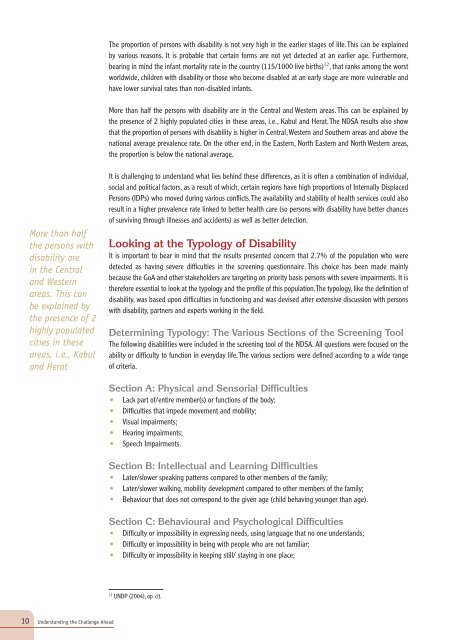Handicap International experience in Afghanistan - CBM
Handicap International experience in Afghanistan - CBM
Handicap International experience in Afghanistan - CBM
- No tags were found...
You also want an ePaper? Increase the reach of your titles
YUMPU automatically turns print PDFs into web optimized ePapers that Google loves.
The proportion of persons with disability is not very high <strong>in</strong> the earlier stages of life. This can be expla<strong>in</strong>edby various reasons. It is probable that certa<strong>in</strong> forms are not yet detected at an earlier age. Furthermore,bear<strong>in</strong>g <strong>in</strong> m<strong>in</strong>d the <strong>in</strong>fant mortality rate <strong>in</strong> the country (115/1000 live births) 12 , that ranks among the worstworldwide, children with disability or those who become disabled at an early stage are more vulnerable andhave lower survival rates than non-disabled <strong>in</strong>fants.More than half the persons with disability are <strong>in</strong> the Central and Western areas. This can be expla<strong>in</strong>ed bythe presence of 2 highly populated cities <strong>in</strong> these areas, i.e., Kabul and Herat. The NDSA results also showthat the proportion of persons with disability is higher <strong>in</strong> Central, Western and Southern areas and above thenational average prevalence rate. On the other end, <strong>in</strong> the Eastern, North Eastern and North Western areas,the proportion is below the national average.More than halfthe persons withdisability are<strong>in</strong> the Centraland Westernareas. This canbe expla<strong>in</strong>ed bythe presence of 2highly populatedcities <strong>in</strong> theseareas, i.e., Kabuland HeratIt is challeng<strong>in</strong>g to understand what lies beh<strong>in</strong>d these differences, as it is often a comb<strong>in</strong>ation of <strong>in</strong>dividual,social and political factors, as a result of which, certa<strong>in</strong> regions have high proportions of Internally DisplacedPersons (IDPs) who moved dur<strong>in</strong>g various conflicts. The availability and stability of health services could alsoresult <strong>in</strong> a higher prevalence rate l<strong>in</strong>ked to better health care (so persons with disability have better chancesof surviv<strong>in</strong>g through illnesses and accidents) as well as better detection.Look<strong>in</strong>g at the Typology of DisabilityIt is important to bear <strong>in</strong> m<strong>in</strong>d that the results presented concern that 2.7% of the population who weredetected as hav<strong>in</strong>g severe difficulties <strong>in</strong> the screen<strong>in</strong>g questionnaire. This choice has been made ma<strong>in</strong>lybecause the GoA and other stakeholders are target<strong>in</strong>g on priority basis persons with severe impairments. It istherefore essential to look at the typology and the profile of this population. The typology, like the def<strong>in</strong>ition ofdisability, was based upon difficulties <strong>in</strong> function<strong>in</strong>g and was devised after extensive discussion with personswith disability, partners and experts work<strong>in</strong>g <strong>in</strong> the field.Determ<strong>in</strong><strong>in</strong>g Typology: The Various Sections of the Screen<strong>in</strong>g ToolThe follow<strong>in</strong>g disabilities were <strong>in</strong>cluded <strong>in</strong> the screen<strong>in</strong>g tool of the NDSA. All questions were focused on theability or difficulty to function <strong>in</strong> everyday life. The various sections were def<strong>in</strong>ed accord<strong>in</strong>g to a wide rangeof criteria.Section A: Physical and Sensorial Difficulties• Lack part of/entire member(s) or functions of the body;• Difficulties that impede movement and mobility;• Visual impairments;• Hear<strong>in</strong>g impairments;• Speech Impairments.Section B: Intellectual and Learn<strong>in</strong>g Difficulties• Later/slower speak<strong>in</strong>g patterns compared to other members of the family;• Later/slower walk<strong>in</strong>g, mobility development compared to other members of the family;• Behaviour that does not correspond to the given age (child behav<strong>in</strong>g younger than age).Section C: Behavioural and Psychological Difficulties• Difficulty or impossibility <strong>in</strong> express<strong>in</strong>g needs, us<strong>in</strong>g language that no one understands;• Difficulty or impossibility <strong>in</strong> be<strong>in</strong>g with people who are not familiar;• Difficulty or impossibility <strong>in</strong> keep<strong>in</strong>g still/ stay<strong>in</strong>g <strong>in</strong> one place;12UNDP (2004), op. cit.10 Understand<strong>in</strong>g the Challenge Ahead
















